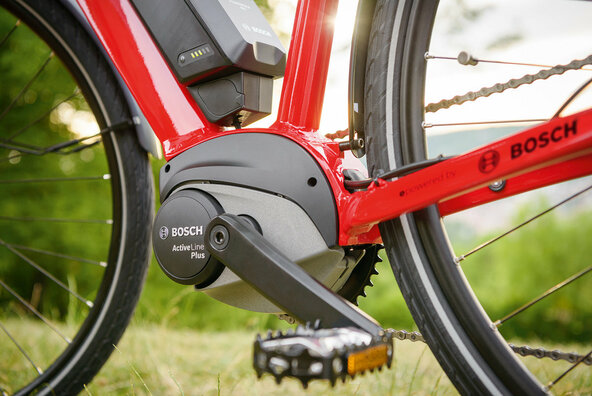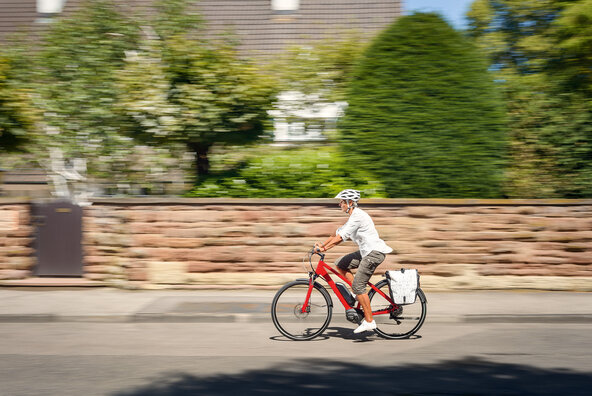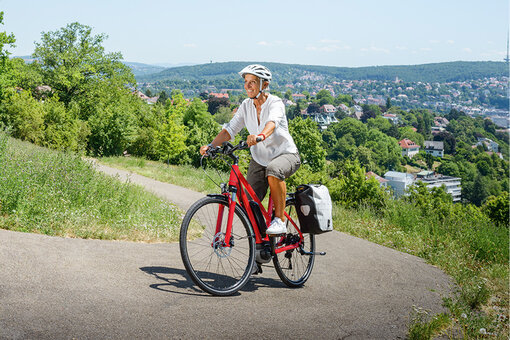
Pump up bicycle tyres: Always on the road with the right air pressure
The tyres of your bike have to withstand you, the bike itself and often luggage and purchases – so the air pressure shouldn't be too low. Wear will increase if you ride for a longer period of time with under-inflated tyres. Plus, it's harder for you to get going. You must not overinflate your tyres either. Our tip: Check the tyre pressure monthly and inflate the bicycle tyres if necessary.
Weight, terrain, tyre width: The air pressure required varies
The correct air pressure in the inner tube of the bicycle tyre depends, among other things, on the tyre width, the surface and the weight load of the rider and luggage. The air pressure is indicated in 'bars' as the units of measurement. On bicycle pumps with a manometer (pressure gauge), the measuring scale often also shows the US unit PSI - one bar is 14.5 PSI; one PSI is 0.07 bar. Conversion tables can be found online.
The air pressure required decreases with increasing tyre width. Racing bikes with narrow tyres need a high air pressure of seven bar and upwards, mountain bikes with their much wider tyres and more tread need two to three bar. When riding off-road, less air pressure is advantageous to have more grip and to absorb shocks better. City bikes and trekking bikes are in the middle of the air pressure range with three to four bar.
The recommended air pressure range is written on the side of the tyre wall. The more the rider weighs, the higher the air pressure has to be. Rolling resistance increases with decreasing pressure. The abrasion area increases, and cracks may appear in the sidewall of the tyre casing.
On an eBike, the electric motor has to work harder if the tyres are not sufficiently inflated. That requires energy. If you optimise the air pressure, you coast better, go further and reduce the risk of punctures.
Check tyre pressure and inflate bicycle tyres regularly
Every bicycle inner tube loses air over time; the air pressure drops by about one bar per month. The higher the pressure, the faster it drops again. Checking the air pressure by pressing it with your thumb is not a reliable method: From about two bar tyres feel fully inflated. But you can't feel the difference between three and four bar. Better: Check the tyre pressure accurately with the pressure gauge as mentioned above.
If the bicycle tyre keeps losing air, you should check the tyre casing for damage and check the inner tube for leaks using a pool of water. You can patch up small holes. Repairing a damaged valve is more complicated. If in doubt, change the bicycle tube and switch to puncture-proof bicycle tyres, for example from Schwalbe.

The different kinds of bicycle valves
There are three types of valves for bicycle tubes: Auto valve (Schrader valve), Express valve (Dunlop valve) and Presta valve (French valve).
Bicycle tubes with a Presta valve are used on racing bikes as well as high-quality trekking bikes and mountain bikes. Presta valves can withstand particularly high air pressures. They are designed to be slimmer than auto and express valves and are available in two lengths (40 and 60 millimetres).
Practical tips: Pump up the bicycle tyres
The best way to do this is to use a compressor or a floor pump. Rotate the wheel so that the
valve is at the bottom. If you want to inflate a Presta valve, loosen the
valve head before fixing the pump head with the locking lever. For the car valve you use
the large opening; for the express valve and Presta valve the small opening on the pump head.
